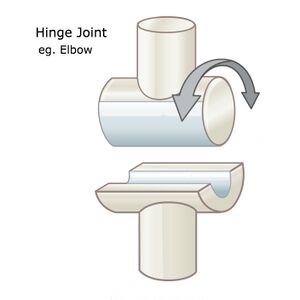⬤
Hinge Joint: Difference between revisions
From WikiMSK
No edit summary |
|||
| Line 4: | Line 4: | ||
== List of {{PAGENAME}}s == | == List of {{PAGENAME}}s == | ||
{{Not ported}}{{#ask: | {{Not ported}}{{#ask: | ||
[[Has joint type::Hinge Joint]] | [[Has joint secondary type::Hinge Joint]] | ||
|?Has joint bones=Bones | |?Has joint bones=Bones | ||
|?Has joint ligaments=Ligaments | |?Has joint ligaments=Ligaments | ||
Revision as of 09:15, 2 April 2022
A hinge joint is an articulation between the convex end of one bone and the concave end of another. This type of joint is uniaxial because it only permits movement in one axis. In the body, this axis of movement is usually bending and straightening, or flexion and extension. Examples include the elbow, knee, ankle, and interphalangeal joints.[1]
List of Hinge Joints
- This section is original unported content
| Synovial Joint | Bones | Ligaments | Muscles | Innervation | Vasculature | ROM | Volume |
|---|---|---|---|---|---|---|---|
| Elbow Joint | Radius Ulna Humerus | Capsule, medial and lateral collateral ligaments, oblique cord, quadrate ligament | Radial, ulnar, median, and musculocutaneous nerves | Anastomotic arcades formed by branches of radial, ulnar, and brachial arteries. | |||
| Interphalangeal Joints (Foot) | Proximal Phalanx (Foot) Distal Phalanx (Foot) | ||||||
| Knee Joint | Tibia Femur Patella | Popliteal nerve, tibial nerve | Genicular branches of the popliteal artery | Mainly sagittal plane: 3° of hyperextension to 155° of flexion | |||
| Tibiotalar Joint (Talocrural Joint) | Tibia Fibula Talus | Syndesmosis, medial collateral ligaments, lateral collateral ligaments | tibial nerve, deep peroneal nerve | anterior and posterior tibial arteries, peroneal artery | 10° to 20° of dorsiflexion, 40° to 55° of plantarflexion | 16-30 mL |
References
- ↑ Juneja, Pallavi; Munjal, Akul; Hubbard, John B. (2022). "Anatomy, Joints". Treasure Island (FL): StatPearls Publishing. PMID 29939670. Cite journal requires
|journal=(help)


